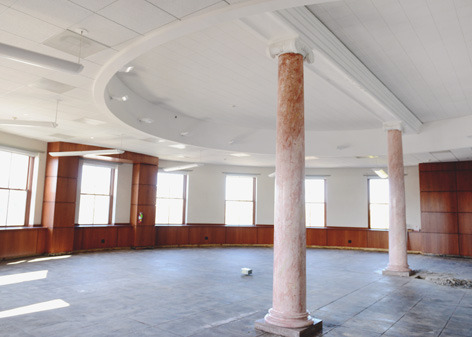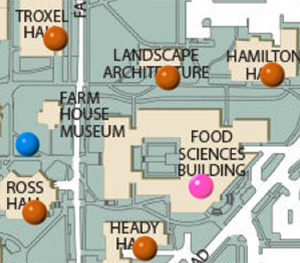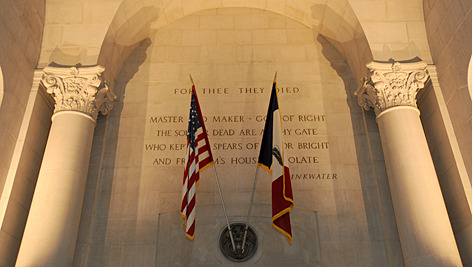Interior demolition at Marston begins next month

Poured concrete walls on the west side will protect the building's new below-grade electrical transformer and switchgear.
All of the furniture is removed and asbestos abatement is complete in Marston Hall, which closed in early August for an 18-month renovation. Crews have removed old mechanical systems from the basement, which exists only under the west rotunda, and currently are pouring concrete walls and tunnels on the west side that will protect new underground utility infrastructure.
Where are they?
A reminder of where Marston tenants temporarily relocated during the renovation.
Last month, the state Board of Regents approved a larger budget for the project -- $27.1 million – in light of the state's competitive construction market and higher-than-expected bids. In fact, second bids on the interior demolition component are due Nov. 13, with that work expected to begin Dec. 1 and continue through July 2015. Project manager Kerry Dixon, facilities planning and management, estimates a May 2016 move-in for College of Engineering tenants.
Marston Hall was completed in 1903. The renovation, which includes all 60,000 square feet of the building, creates classrooms and student services, visitor and student spaces on the first two floors, and moves the college's administrative units to the top two floors. The project is being paid for by university and college funds (about two-thirds) and private gifts (about one-third).
Photos by Amy Vinchattle.

The Marston partial basement, below the rotunda and previously accessible via tunnels from the main part of the building, will become a working basement in the renovation.

The top floor of the rotunda, formerly home to Engineering career services, will become a multipurpose conference/event room in the renovation.
Check your building on the new energy dashboard
The new energy dashboard on the university website resembles a personal activity tracker on an institutional scale, with a key exception. While personal trackers generally aim to encourage more energy use on the part of its wearers, the energy dashboard strives to inspire less.
Like the personal tracker, the ISU dashboard provides plenty of data, allowing the university community to see the effects of its energy-related actions. The site includes a real-time pie chart that shows which of the big three energy needs -- heating, cooling or electricity -- is commanding the biggest slice at any given moment along with more detailed information on individual buildings.

A dashboard map colors buildings on campus, based on BTU-per-square-foot use.
Lindsey Wanderscheid, project engineer for utilities, says facilities, planning and management staff hope the dashboard will help people across campus find ways to reduce energy consumption in their buildings. She suggests special attention to these pages:
- Campus map: Provides an overview of most campus buildings, color-coded by energy use per square foot.
- Compare buildings: Compares all facilities, based on BTUs per square foot. A pull-down category allows comparisons between like buildings, such as academic, science and research, or housing facilities.
- Select building: Offers detailed energy data for each facility on campus.
When it comes to energy savings, all buildings aren't created equal. Wanderscheid points out that science and research buildings generally use more energy than, for example, administrative buildings. And a decades-old facility likely won't fare well in BTU competition with the LEED-certified upstarts.
However, whether your building is old or new, there's always room for improvement and the energy chart data may well point the way. For example, Wanderscheid said, an unexpected surge in chilled water may be a sign of a leak somewhere. A building that's consistently consuming considerably more energy than similar facilities may benefit from a closer assessment by FPM experts.
A good place to start
Wanderscheid suggests building occupants keep an ever-present eye on electricity costs. Turning off unused computers, lights, research equipment, coffee machines and other appliances can make a real difference in energy and environmental costs.
"If you don't use the electricity," she said, "we don't have to burn the coal or make the steam."
Lackey responds to more TIER questions
Members of the Professional and Scientific Council heard an update on the state Board of Regents' efficiency review from associate vice president and chief of staff Miles Lackey. Lackey represents Iowa State on the review committee.
"The main objectives associated with TIER (Transparent Inclusive Efficiency Review) is to operate more efficiently, more effectively and to optimize the revenue streams," Lackey said.
Lackey fielded these questions about the TIER process:
Are the 250 staff positions to be eliminated at ISU, or across the three regents schools?
"I think it is important to stress that these opportunities -- particularly the ones that are involving FTE reductions -- have not even been approved yet. The changes and savings have not been verified. I think it is way too early to have a tremendous amount of confidence in those estimates."
Were people in the positions that will be directly affected by the business cases consulted as part of the study?
"Yes, in most of the cases. However, because a lot of that extensive design work has not yet been accomplished, I can't say that in every specific circumstance that would be the case. Before anything would be implemented or changed, those folks would be engaged in the process."
Will all or part of the proposed business cases require mandatory implementation?
"If the cases are adopted by the board of regents, then the institutions will be expected to implement the changes. There will be quite a bit of flexibility from one institution to the next."
What reporting to the board of regents is required regarding implementation of the business cases?
"For each of the individual business cases, you will have a university lead on each campus. Depending on the case, you will have a team or council tasked with helping to move forward that implementation. Reporting back will focus on agreed-upon key performance indicators for those opportunities."
What does the implementation process for the approved business cases look like?
"It will look very different from one opportunity to the next. Some of these are likely to be -- or already are -- university- and/or regents-led, some are likely to be consultant-coached, and some of them even could be consultant-driven."
Can you provide an update on academic cases and how that will work going forward?
"The regents are now in the process of trying to identify and select a new subcontractor to work on the academic components of the TIER study. There are a couple of opportunities which I do anticipate moving forward simultaneous to the selection process -- that would be some of the classroom scheduling pieces (being done by another subcontractor)."
How strongly has ISU responded to the opportunities brought forward by the Deloitte consultants?
"We've been very, very candid. I appreciate the ability to have that kind of dialogue with the regents and task force members."
How will ISU measure the effect of the changes and their success?
"It really is going to take a 'balanced score card' approach. We're going to have to think in a very thoughtful and prudent way. We certainly don’t want to get to the point where we are sacrificing quality to save a few pennies."
New unit takes on student debt
Faculty and staff: Have students shared financial reasons behind their need to drop a class or leave school for a semester? Do you have students falling behind academically because they're working multiple jobs to stay in school?
A new office in the student financial aid program aims to head off such statistics. The goal of the Student Loan Education Office, created through a partnership of the student affairs division and the Government of the Student Body (GSB), is to improve the overall financial health of Iowa State students and reduce their education loan debt through individual counseling and group presentations.
Student Loan Education Office
Location: 0680 Beardshear (northwest corner, ground floor)
Phone: 294-0677
Director of student financial aid Roberta Johnson said a primary message to students is to plan and budget long range -- not just a semester or a year at a time – and to recognize how day-to-day spending decisions reinforce or undermine their long-range plans.
"We're trying to touch as many students as we can," Johnson said. "Freshmen will be our first focus, but we are helping upperclassmen and graduate students, too."
Johnson encouraged faculty and staff to refer students to the new service.
Jennifer Schroeder, an eight-year veteran of the student financial aid office who leads the new office, said financial counselors can help students understand setting and living within a budget, the cost of borrowing money and what repayment will look like, credit, and implications of borrowing on their credit rating, among other topics. For requests that are beyond a typical student's experience – investments or home ownership, for example – Schroeder said students will be referred to an appropriate source, on or off campus.
GSB proposal
The new service is the outcome of a GSB request last spring to senior vice president for student affairs Tom Hill. In past years, GSB provided some funding to the Financial Counseling Clinic based in the human development and family studies department. A regular GSB audit in February of some of the campus units it supports noted that the clinic's focus was moving away from student service to faculty research and graduate student training.
"What we were looking for is financial counselors who are giving 100 percent of their time to counseling students," said GSB president Hillary Kletscher. "That was key to us as we made our shift. The student body funding this new office says that this is really important to us."
GSB leaders went to Hill with the general concept and negotiations began to create a new service unit within student financial aid. It opened in August on the ground floor of Beardshear Hall; on Oct. 22, senators approved nearly $117,000 in support for the Student Loan Education Office.
"Students often are as stressed about finances, about paying for school and rent and food, as they are about classes," Kletscher said. "We want help with this, but we don't always know where to get help."
While students initially pushed for a broader scope of services in the office, Kletscher said a presentation by recently retired professor of human development and family studies Tahira Hira "shifted our perspective."
"We realized the depth and width of the student loan debt crisis and saw the merits of an office that focuses more narrowly," she said.
Live like a student
When it's fully staffed, the student loan education office will include Schroeder and three other fulltime financial counselors. Two arrived in mid-September and are wrapping up a training period, and the last search will open yet this fall. Five part-time student employees staff the front desk and Schroeder said she hopes to hire one or two graduate assistants this year to assist with counseling.
Schroeder and her staff are making group presentations this semester, many to freshman classes, but also in a few senior seminars to begin the conversation about loan repayment and budgeting after college. Learning communities and student organizations also requested presentations. She said they will use both strategies – one-on-one sessions and class presentations – to assist students.
"We hope we build relationships with students, and that they come back and see us," she said.
Schroeder attended a first-of-its-kind conference this summer on student financial literacy in higher education. More than 150 schools sent representatives.
"A lot of schools are paying attention to this topic. How they structure the service looks different at different schools," she said.
But a very common theme among them is to encourage students to live like students now -- so they don't have to when they graduate.
Johnson noted that the array of opportunities available to Iowa State students also adds to their financial decisions.
"Maybe it's a phenomenal study abroad opportunity in their junior year, maybe it's a spring break trip they really can't afford," she said. "We won't tell students what to do, but we'll give them their options and the consequences of each."
Information advisors can assist with harassment, discrimination complaints
Brenda loves her job, at least she used to. Everything was going well until Mark joined the department. He was funny at first, cracking jokes about harmless things. But lately, his so-called funny remarks are no laughing matter. He tells Brenda inappropriate, sexually explicit jokes and makes vulgar comments about her body. Brenda now dreads going to work. She still enjoys her job and doesn't want to leave, but she is tired of Mark's shenanigans.
Brenda, Mark and this scenario are fictitious. But unfortunately, similar situations are a reality. That's why Robin Kelley, director of the Office of Equal Opportunity, recently created the OEO information advisors, a group of 20 individuals who have been trained to assist faculty, staff and students experiencing any form of harassment, including sexual harassment, or discrimination on campus. The group replaces the former discrimination and harassment assistors program.
Purpose of the information advisors
The information advisors are unit-level contacts for faculty, staff and students who would like to talk with someone about a harassment or discrimination incident related to race, color, age, religion, sex, sexual orientation, gender identity, genetic information, national origin, marital status, disability or protected veteran status. The advisors help ensure the university responds appropriately and effectively to situations that violate state and federal laws requiring a nondiscriminatory and harassment-free workplace and educational environment. The advisors also provide individuals with information about university and community resources.
Information advisors do not conduct investigations or act as advocates for complainants. Faculty, staff and students may contact any information advisor, not necessarily the persons assigned to their colleges or departments, or where the incident occurred.
"Information advisors provide a safe place for individuals to talk about issues, explore university options and provide necessary resources," Kelley said. "Information advisors can connect faculty, staff and students to departments on campus, including OEO."
Confidentiality not guaranteed, but respected
A key difference between the new advisors group and the former assistors group is that when an information advisor receives a report of harassment or discrimination, those reports are no longer confidential.
"The assistors program was a strictly confidential resource for employees to report discrimination and harassment. The problem was, no one was reporting incidents to the OEO so we couldn't address or track complaints, which we are required to do by law," Kelley said. "We want to create a climate where people feel comfortable coming forward. That's how we elicit change."
Kelley said that while conversations with information advisors will be reported to the OEO, the information may or may not result in a complaint or investigation, depending on the nature of the report. When confidentiality is requested, it will be honored in most cases.
"Just because an information advisor has reported an employee or student incident to OEO does not mean that the employee or student must file an official complaint," she said. "In most cases, the information will stay in the OEO, unless the situation presents a safety issue or danger to the campus community. Under Title IX, the institution is required to take certain actions but even in those circumstances, we cannot compel individuals to file complaints."
Information advisors are also advised to let individuals know they can discuss hypothetical situations without mentioning specific names, dates or places. But once concrete details are provided, the information advisors are required to report the incident to the OEO and, in some cases, the Title IX coordinator directly.
More information about the role of the information advisors is on the OEO website.
How the information advisors were selected
Members of the information advisors group were appointed by university administrators last spring to represent Iowa State's colleges and other departments across campus. Members were not required to have a legal background, but rather be trustworthy individuals with good judgment.
Kelley has conducted extensive training with the group. The training will continue annually or as discrimination and harassment laws change.
"The information advisors are our connection to departments and are our partners since our office can't be everywhere," Kelley said. "These group members are the bridge between us and the campus, and help us ensure a campus that is inclusive, welcoming and free from discrimination and harassment."
Fallen military to be honored Nov. 11

A living memorial
- In 1928, the names of 117 Iowa Staters who died during World War I were carved into the walls.
- In 1969, 10 bronze plaques bearing the names of 369 Iowa State men who died in World War II were mounted on doors to the Gold Star Hall.
- In 1984, the bronze plaques were removed when names from World War II, Korea and Vietnam were engraved in the limestone walls.
- Name additions have also been made in 2003, 2006 through 2011 and 2013, adding overlooked servicemen from World War II, Korea, Vietnam, as well as Somalia, Iraq and Afghanistan.
Iowa State's student union was built in 1928 as a memorial to students and alumni who died in World War I. Their names are engraved in the walls of the union's Gold Star Hall -- the spatial expression of the word memorial in Memorial Union. As more fallen former Iowa State students become known, their names are added to the wall.
This year, three new names are being engraved there -- one who died in May in Afghanistan, one who died on the USS Liberty in the Six-Day War and another from World War II. Iowa State's Gold Star Hall Ceremony will honor them along with two other fallen servicemen whose names were previously engraved, but their sacrifices not publicly remembered.
The Gold Star Hall Ceremony will be at 3:15 p.m. Tuesday, Nov. 11, in the Memorial Union Great Hall. The ceremony is free and open to the public. A reception in the Gold Star Hall will follow.
During the ceremony, all five will be remembered through personal anecdotes and photos. Their extraordinary stories span nearly a century and four conflicts.
- Deric Rasmussen, Storm Lake, who attended Iowa State between 1999 and 2002, died in Afghanistan on May 11.
- Donald Lee Sparks, Glidden, was a 1968 ISU graduate initially listed MIA in South Vietnam in June 1969. He was later declared a POW and is believed to have died in captivity.
- Charles Douglas King, Muscatine, was a pararescueman during the Vietnam War. He went missing in action on Dec. 25, 1968, while attempting to rescue the body of a pilot in Laos. A highway in Muscatine and buildings on several military bases are named for him.
- Jerry Leroy Converse, Boone, was killed June 8, 1967, aboard the USS Liberty off the shore of Egypt at the time of the Six-Day War.
- Maurice Raskin, Woodbury, a pre-veterinary medicine student at Iowa State, was killed in a strafing mission over Italy in 1943.
